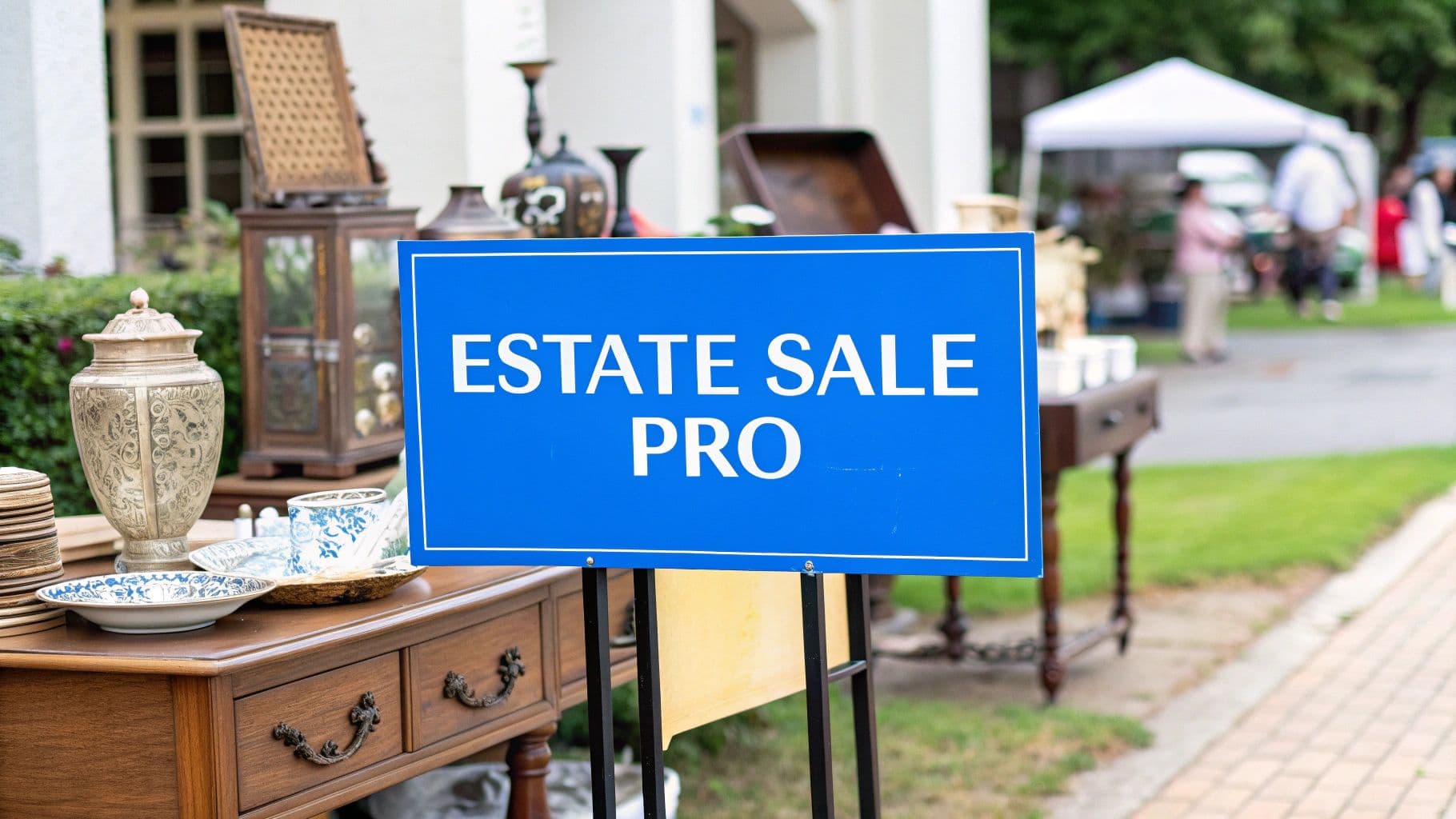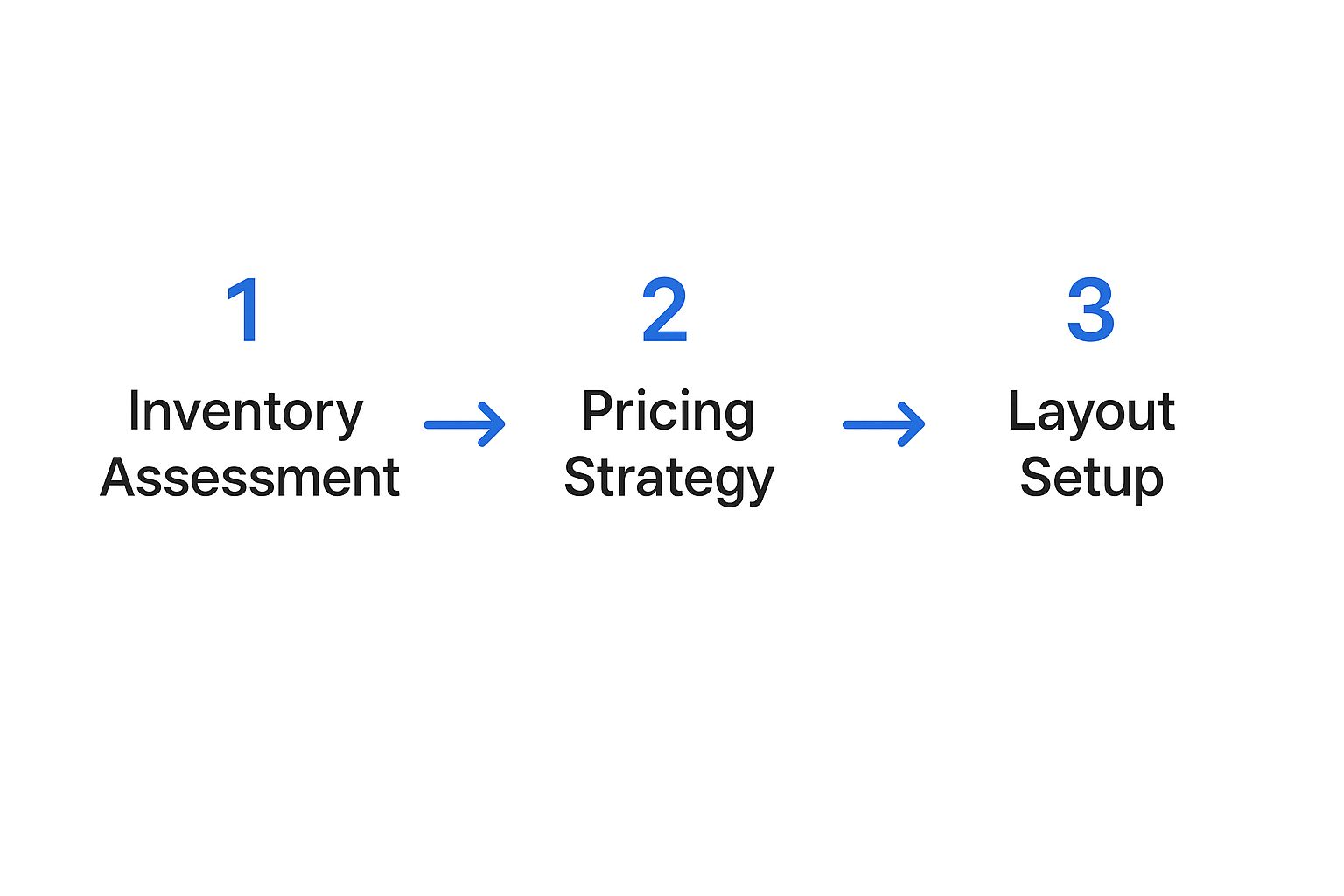Your Guide to Being an Estate Sale Organizer

So, you’re thinking about running an estate sale. The first thing to know is that someone has to be in charge—the organizer. This person is the project manager for liquidating everything in the home, and that role can fall to you or a professional you hire.
Your decision really boils down to your own time, emotional energy, and just how complex the estate is. Whether you take the reins as a DIY estate sale organizer or hand them over to an expert, one thing is certain: you need a solid game plan.
Laying the Groundwork for a Successful Sale
Long before you price a single teacup or drag a table into the living room, the most important work begins. Don't mistake this for a glorified garage sale. Organizing an estate sale is a serious project, and it demands clear goals, a realistic schedule, and an honest look at what you can handle. The foundation you lay right now will make all the difference in your final profits—and your sanity.
First Things First: Define Your Primary Goal
Before you do anything else, you have to decide what a "win" looks like for you. This one decision will guide everything that comes next, from how you price antique furniture to how long the sale runs.
Are you trying to:
- Maximize Profit? This approach means more research, careful pricing, and being patient enough to wait for the right buyers. It takes time.
- Clear the Property Quickly? If you're on a tight deadline to sell the house, your main focus will be moving items fast. This often means accepting lower prices to get the job done.
- Find a Healthy Balance? This is where most people land. You want to make a fair amount of money without letting the process drag on forever.
Nailing down your goal from the start helps keep emotions out of your business decisions and gets everyone on the same page.
The Big Question: DIY vs. Hiring a Pro
Your next major decision is whether to run the show yourself or call in an expert.
Going the DIY route saves you from paying commission fees, but it's a massive commitment of time and sweat. You'll be the one sorting, pricing, marketing, and managing the sale from start to finish. If that sounds daunting but you still want to do it yourself, you can find great estate sale help to guide you through the trickier parts of the process.
On the other hand, hiring a professional estate sale company can be a godsend, especially when you're dealing with grief or feeling overwhelmed. These folks handle everything, but that convenience comes at a cost—typically 30% to 50% of the total sales.
It’s a personal service industry, usually run by small, focused teams. A 2023 survey found that 74% of professionals focus exclusively on estate sales. What’s more, 28% are solo operators, and another 20% have just one or two employees. This isn't some faceless corporation; you’re often hiring a small, dedicated crew, which can be exactly what you need when sorting through a lifetime of memories.
Sorting and Cataloging a Lifetime of Possessions
With your goals mapped out, it's time to roll up your sleeves and dive into the most hands-on part of the job. Sorting through a lifetime of belongings is always a bit of an emotional rollercoaster, but having a clear, methodical plan is your best defense against feeling overwhelmed. Think of yourself as an organizer bringing order to chaos—get this right, and every other step becomes infinitely easier.
The best way to start is one room at a time. I always recommend beginning in a space with less emotional attachment, like a guest room or a bathroom. This helps you build momentum before you tackle more personal areas like the master bedroom or a home office.
As you go, create four simple zones in each room:
- Sell: Items you'll price and display for the sale.
- Keep: Personal belongings for family members. Get these out of the house or into a locked, clearly marked room immediately to prevent any mix-ups.
- Donate: Things that are in good shape but might not sell.
- Discard: Anything that's broken, badly stained, or otherwise unusable.
This system forces you to make a deliberate choice for every single item, preventing the dreaded "I'll deal with it later" pile from taking over.
Building Your Inventory System
Once you've started sorting, you need a way to track everything you plan to sell. A solid inventory isn't just for you; it's a crucial tool for accountability and making sure nothing walks away unpaid for. For a DIY sale, a simple spreadsheet is your best friend.
Set up columns for a description of the item, where it's located in the house, its condition, any notes (like brand names or age), and a blank column for the price you'll set later. Trust me, being specific now saves major headaches down the road. "Vintage Pyrex Cinderella Bowl Set of 4" is infinitely more helpful than just "bowls" when it's time to research pricing.
A detailed catalog might feel tedious in the moment, but it's the single step that transforms a house full of stuff into a manageable business inventory. This is the professional's secret to a controlled, profitable, and transparent sale.
Spotting Hidden Treasures
While you're cataloging, keep your treasure-hunting eyes open. Not everything old is valuable, but some modern pieces can be surprisingly popular. Get in the habit of looking for signatures on artwork, maker's marks on the bottom of ceramics and silver, and designer names on costume jewelry.
Online resources are a fantastic place to start your research. Sites like EstateSales.net are goldmines of information, showing you what items are currently trending with buyers.

Look at what other professional sales in your area are highlighting. It gives you direct insight into what local buyers are searching for.
If you come across something you think could be genuinely valuable—a piece of fine art, a rare book, or a high-end antique—set it aside. Do not guess its price. It is always worth paying a small fee to consult a professional appraiser for these key items. That small investment can prevent you from accidentally selling a $1,000 piece for $50.
Pricing and Staging to Maximize Your Profits
This is where all your hard work starts to pay off. Smart pricing and thoughtful staging are the two things that separate a chaotic cleanout from a seriously profitable estate sale. If you nail these, you won't just draw in bigger crowds—you'll get them to open their wallets once they're inside.
First things first: you have to take the emotion out of it. What an item means to you has zero bearing on what someone will actually pay for it. The goal is to land in that sweet spot between what you wish it was worth and what the market dictates today.
The Art and Science of Pricing Your Items
Good pricing isn't about guessing; it's about a little bit of detective work. A decent rule of thumb for regular household goods is to aim for 25-30% of their original price. But that’s just a baseline. For anything with a bit of age, a brand name, or a collectible feel, you need to dig deeper.
Here’s how you can get it right:
- Check Online Comps: Hop on a site like eBay and search for the exact item. Here's the key: filter the results to show “Sold” or “Completed” listings. This is pure gold, telling you what people actually paid, not just what sellers are asking.
- Be Honest About Condition: A pristine piece from a well-known brand will always fetch more. Be ruthless in your assessment of scratches, chips, or wear and tear, and let the price reflect it.
- Bundle the Small Stuff: That drawer of random kitchen gadgets? The stack of beach-read paperbacks? Group them. It's way easier to sell a "Kitchen Gadget Bundle" for $5 than to price 20 individual spatulas for a quarter each.
Doing this bit of homework gives you confidence. When a shopper tries to haggle, you’ll know your price is based on real-world data, not just a random number you plucked from thin air.
Here’s a quick-reference table to help you get started on pricing some common household goods. Remember, condition is everything!
Sample Pricing Guide for Common Estate Sale Items
| Item Category | Condition Good | Condition Very Good | Condition Excellent or Like New |
|---|---|---|---|
| Hardcover Books | $1 - $2 | $2 - $4 | $5+ (or 30-40% of retail) |
| Paperback Books | $0.50 - $1 | $1 - $2 | $2 - $3 |
| Standard Kitchenware | $1 - $3 per piece | $2 - $5 per piece | Bundle for higher value |
| Small Appliances | $5 - $15 | $15 - $25 | 30-50% of retail |
| Solid Wood Furniture | $50 - $150 | $150 - $400 | $400+ (research brand) |
| Wall Art (Prints) | $5 - $20 | $20 - $40 | $50+ (depending on frame/artist) |
| Hand Tools (Individual) | $1 - $5 | $5 - $10 | $10+ (brand dependent) |
| Vinyl Records (Common) | $1 - $3 | $3 - $5 | $5 - $8 |
This table should serve as a solid starting point, but always do a quick search for any brand-name or particularly unique items you come across.
Staging Your Home Like a Boutique
With everything priced, it’s time to switch hats from appraiser to merchandiser. You need to make the home feel less like a private residence and more like a welcoming shop. People buy more when they're comfortable and can easily see what's available.
A well-staged home doesn't just display items; it sells a lifestyle. By creating clean, organized, and visually appealing vignettes, you elevate the perceived value of everything in the room, encouraging buyers to linger and spend more.
This is the professional flow—from sorting and inventory to a beautifully staged sale.

This systematic approach is what the pros do, and it works. The estate liquidation industry is huge, generating $230.3 million in revenue in the U.S. as of 2024. What’s interesting is that no single company has more than a 5% market share, meaning there's a massive opportunity for well-run independent sales to capture a piece of that pie. You can see the full breakdown in these estate liquidation services market trends on ibisworld.com.
Think about shopper flow. You need to create obvious pathways so people aren't bumping into each other or knocking things over. Open all the curtains, turn on every light, and make the space bright and inviting. If you have a standout piece of furniture or art, shine a lamp on it. And please, group like items together! All the glassware goes on one table, all the tools in the garage. It makes the experience so much better for your customers.
Promoting Your Sale to Attract Eager Buyers
You can sort, stage, and price everything perfectly, but none of it matters if shoppers don’t show up. Smart promotion is what turns your private cleanout into a public can't-miss event. A solid marketing plan isn't just a nice-to-have; it's the engine that guarantees a steady stream of buyers from the moment you open your doors.

You’ll want to start building buzz a couple of weeks in advance. This gives serious buyers, the ones who plan their weekends around sales, enough time to get yours on their calendar. This is about more than just posting an address—it’s about telling a compelling story and creating a sense of urgency.
Crafting Irresistible Online Listings
Today, the primary battlefield for attracting buyers is online. Start with dedicated estate sale listing websites where seasoned shoppers are already hunting. From there, cast a wider net on platforms like Facebook Marketplace and in local community groups.
Your ad’s success really boils down to two things: a compelling description and fantastic photos.
- Write a magnetic headline. Instead of just "Estate Sale," try something like, "Vintage Collector's Estate Sale: Mid-Century Furniture, Tools & More!" Get specific and hook them with your best stuff.
- Highlight the good stuff first. Mention unique, high-demand items right at the top of your description. Think brand names, antiques, or large collections that will grab attention immediately.
- Use incredible photos. Natural light is your best friend here. Take clear, uncluttered photos of your most desirable items and show off beautifully staged areas. A picture of a neat vignette is always more powerful than a photo of a cluttered table.
These details are what elevate a simple listing into an event people are genuinely afraid to miss. For a deeper dive, check out our complete guide to estate sale marketing.
The Power of Physical Signs
Even in a digital world, never, ever underestimate the power of old-school signage. Bright, clear, and simple signs are your secret weapon for capturing local drive-by traffic—people who weren’t even looking for a sale until they saw your sign.
Place them at major intersections near the home and at every single turn leading to your street.
Your marketing efforts tap into a thriving market. A skilled estate sale organizer is a key player in the global liquidation services field, which was valued at $3.32 billion in 2021 and is projected to grow. North America holds the largest share, making your well-promoted sale part of a significant economic trend. Discover more insights about the growth of the liquidation service market on cognitivemarketresearch.com.
Make sure your signs are all uniform with large, bold lettering and a giant, can't-miss directional arrow. Consistency helps drivers easily follow the path right to your door, turning a curious passerby into your next best customer.
Managing the Sale Days Like a Pro
The moment that first customer walks through the door, the whole energy changes. This is showtime. Your success now hinges on how well you can manage the flow of people, questions, and money. You’ve shifted from being a curator to an event manager, and having a solid game plan is absolutely essential.

Let's be clear: you can't do this alone. You need a team of at least three people. One person should be dedicated to the checkout station, another roaming the sales floor to help shoppers, and a "floater" who can back up both, help carry heavy items, and generally keep an eye on things. If you're working in a large home, you'll definitely want more people on the floor for both customer service and security.
Setting Up a Secure Checkout Station
Think of your checkout area as the central command post for the entire sale. Pick one spot—ideally near the main exit—and make it the only place where money changes hands. This cuts down on confusion and seriously minimizes the risk of theft.
You'll want to stock your station with the right tools to keep things moving smoothly:
- Payment Options: Be ready for cash, but don't stop there. People expect to pay with cards or mobile apps like Venmo or Square. Turning someone away because you can't take their payment is one of the easiest ways to lose a sale.
- Cash Box: You'll need to make change, so start the day with around $100 in small bills and coins. A fanny pack or a cashier's apron is a fantastic way to keep your cash secure and right on your person.
- Supplies: Keep a stash of bags, wrapping paper for fragile finds, and a calculator handy. For big-ticket items like furniture, a sold-tag system with tear-off receipts is a non-negotiable.
Handling Negotiations and Difficult Customers
Haggling is part of the fun of an estate sale, so expect it. But you also have to be ready for the inevitable lowball offers, especially on day one. A polite but firm, "I can't go that low today, but feel free to check back tomorrow," works wonders.
That simple phrase respects the buyer's offer while letting them know you're holding firm on your price, at least for now. Remember, the goal is to get a fair price, not to liquidate everything in the first hour. This kind of day-of management is a critical skill, and you can find more strategies for how to organize an estate sale to build up your confidence.
The initial morning rush can be the most hectic part of the day. Don't be afraid to control the flow at the door. Letting in a manageable number of shoppers at a time prevents the house from becoming a chaotic free-for-all, which keeps both your customers and the items safe.
By staffing correctly, staying organized, and being prepared for any customer interaction, you can turn a potentially stressful day into a profitable, smoothly run event. Your professional and calm demeanor will set the tone for the entire sale.
Answering Your Top Estate Sale Questions
https://www.youtube.com/embed/jr7WFRSRYMI
No matter how airtight your plan is, questions will pop up. Unexpected things happen. That’s just the reality of running a sale. The trick is to have your answers ready before the questions are even asked.
Having a solid policy for common scenarios—like price negotiations or what to do with leftovers—is what separates a stressful sale from a smooth one. Let's walk through some of the most common curveballs you're likely to face.
Should I Negotiate Prices with Customers?
In a word, yes. Haggling is part of the culture and, for many shoppers, part of the fun. But you can't let your best stuff walk out the door for a steal on the first morning. You need a system.
A tiered discount schedule is the gold standard here. It’s fair, easy to explain, and it works.
- Day One: Prices are firm. This is when the serious buyers and collectors show up, and they're usually ready to pay the tag price for something they really want.
- Day Two: Introduce a set discount, like 25% off. This brings back the folks who were on the fence yesterday and creates a nice sense of urgency.
- Final Day: Go big. We’re talking 50% off or more. The goal now isn’t maximizing profit; it’s liquidating inventory. You want the house empty.
When a customer makes an offer on day one, you have a simple, polite script: “We aren’t discounting today, but everything will be 25% off tomorrow morning!” It sets a clear boundary and treats everyone equally.
How Should I Handle Valuable Items?
Anything that looks valuable—fine china, antique furniture, jewelry, artwork—needs to be handled with care from the very beginning. First things first: get a professional appraisal. Don't ever guess. An appraiser gives you a defensible price, which is your best tool when negotiating with a knowledgeable buyer.
Once the sale starts, these items cannot just sit out on a table in the middle of a crowded room. That's asking for trouble.
Keep your high-ticket items right by your side. A locked glass case or a spot behind the checkout table is perfect. Constant supervision is your number one defense against theft or breakage.
And for those truly museum-quality pieces? An estate sale might not be the right venue. Consider consigning them to a specialty auction house. They have the connections to reach a global network of serious collectors willing to pay top dollar.
What Is the Best Plan for Unsold Items?
Let’s be realistic: you will have things left over. It’s a guarantee. A smart estate sale organizer has a clean-out plan in place before the first customer even walks through the door.
Your final goal is a completely empty house. The best way to ensure that happens is to make arrangements ahead of time.
Have a local charity lined up for a donation pickup. Then, schedule a junk removal service to haul away whatever is left. Getting these appointments on the calendar before the sale means you can clear the property in a day or two, not a week or two.